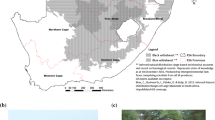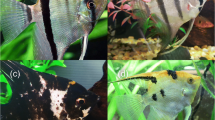Abstract
The grand jackknife clam Solen grandis (Dunker, 1861) is an overexploited bivalve species. In order to promote a conservation program for this species, it is necessary to evaluate its genetic diversity and population genetics. For this purpose, we isolated the first set of 18 polymorphic microsatellite markers and examined their allelic variation using a total of 30 wild individuals collected from one locality. The number of alleles per locus ranged from 5 to 24, and the observed and expected heterozygosity varied from 0.300 to 0.967 and from 0.721 to 0.952, respectively. The high variabilities at these loci indicated that they would be useful tool for exploring the population genetics of S. grandis.
Similar content being viewed by others
References
Carlsson J, Morrison CL and Reece KS (2006) Wild and aquaculture populations of the eastern oyster compared using microsatellites. J. Hered. 97: 595–598.
Chapuis MP and Estoup A (2007) Microsatellite null alleles and estimation of population differentiation. Mol. Biol. Evol. 24: 621–631.
Chapuis MP, Loiseau A, Michalakis Y, Lecoq M and Estoup A (2005) Characterization and PCR multiplexing of polymorphic microsatellite loci for the locust Locusta migratoria. Mol. Ecol. Notes 5: 554–557.
Chen AH, Yao GX and Zhang ZW (2009) Studies on artificial propagation of Solen grandis (Dunker) in pilot scale. Mar. Fish. 31: 66–72.
Chistiakov DA, Hellemans B and Volckaert FAM (2006) Microsatellites and their genomic distribution, evolution, function and applications: A review with special reference to fish genetics. Aquaculture 255: 1–29.
Dai CJ (2002) Evaluation on nutrition componets of the soft part in Solen grandis. J. Jimei Univ. 7: 304–308.
Dakin EE and Avise JC (2004) Microsatellite null alleles in parentage analysis. Heredity 93: 504–509.
De Sousa SN, Finkeldey R and Gailing O (2005) Experimental verification of microsatellite null alleles in Norway spruce (Picea abies [L.] Karst.): implications for population genetic studies. Plant Mol. Biol. Rep. 23: 113–119.
Dieringer D and Schlötterer C (2003) Microsatellite analyser (MSA): a platform independent analysis tool for large microsatellite data sets. Mol. Ecol. Notes 3: 167–169.
Gardner MG, Cooper SJB, Bull CM and Grant WN (1999) Isolation of microsatellite loci from a Social Lizard, Egernia stokesii, using a modified enrichment procedure. J. Hered. 90: 301–304.
Jarne P and Lagoda PJL (1996) Microsatellites, from molecules to populations and back. Trend Ecol. Evol. 11: 424–429.
Lehmann T, Besanky NJ, Hawley WA, Fahey TG, Kamau L and Collins FH (1997) Microgeographic structure of Anopheles gambiae in western Kenya based on mtDNA and microsatellite loci. Mol. Ecol. 6: 243–253.
Li JJ and Li Q (2008) Isolation and characterization of twelve novel microsatellite loci in the ark shell Scapharca broughtonii. Conserv. Genet. 9: 1055–1057.
Li Q, Yu H and Yu RH (2006) Genetic variability assessed by microsatellites in cultured populations of the Pacific oyster (Crassostrea gigas) in China. Aquaculture 259: 95–102.
Liu J, Li Q and Kong LF (2009) Isolation and characterization of 13 microsatellite loci in the pen shell Atrina pectinata (Bivalvia: Pinnidae). Conserv. Genet. 10: 1369–1371.
McGoldrick DJ, Hedgecock D, English LJ, Baoprasertkul P and Ward RD (2000) The transmission of microsatellite alleles in Australian and North American stocks of the Pacific oyster (Crassostrea gigas): selection and null alleles. J. Shellfish Res. 19: 779–788.
Naciri Y, Vigouroux Y, Dallas J, Desmarais E, Delsert C and Bonhomme (1995) Identification and inheritance of (GA/TC)n and (AC/GT)n repeats in the European flat oyster Ostrea edulis (L.). Mol. Mar. Biol. Biotechnol. 4: 83–89.
Naish KA and Boulding EG (2001) Trinucleotide microsatellite loci for the zebra mussel Dreissena polymorpha, an invasive species in Europe and North America. Mol. Ecol. Notes 1: 286–288.
Pemberton JM, Slate J, Bancroft DR and Barrett JA (1995) Nonamplifying alleles at microsatellite loci: a caution for parentage and population studies. Mol. Ecol. 4: 249–252.
Reece KS, Ribeiro WL, Gaffney PM, Carnegie RB and Allen SK Jr (2004) Microsatellite marker development and analysis in the eastern oyster, Crassostrea virginica: confirmation of null alleles and non-Mendelian segregation ratios. J. Hered. 95: 355–361.
Rousset F (2008) GENEPOP’007: a complete re-implementation of the GENEPOP software for Windows and Linux. Mol. Ecol. Resour. 8: 103–106.
Rousset F and Raymond M (1995) Testing heterozygote excess and deficiency. Genetics 140: 1413–1419.
Rubinsztein DC., Amos W, Leggo J, Goodburn S, Jain S, Li SH, Margolis RL, Ross CA and Ferguson-Smith MA (1995). Microsatellite evolution-evidence for directionality and variation in rate between species. Nature Genet. 10: 337–343.
Schlötterer C (2000) Evolutionary dynamics of microsatellite DNA. Chromosoma 109: 365–371.
Smith C, Benzie JAH and Wilson KJ (2003) Isolation and characterization of eight microsatellite loci from silver-lipped pearl oyster Pinctada maxima. Mol. Ecol. Notes 3: 125–127.
Vadopalas B and Bentzen P (2000) Isolation and characterization of di- and tetranucleotide microsatellite loci in geoduck clams, Panopea abrupta. Mol. Ecol. 9: 1435–1436.
Van Oosterhout C, Hutchinson WF, Wills DPM and Shipley P (2004) MICRO-CHECKER: software for identifying and correcting genoty** errors in microsatellite data. Mol. Ecol. Notes 4: 535–538
Wilson AB, Boulding EG and Naish KA (1999) Characterization of tri- and tetranucleotide microsatellite loci in the invasive mollusc Dreissena bugensis. Mol. Ecol. 8: 692–693.
Yang DJ and Wang YL (1996) Marine Invertebrate in Northern China. High Education Press, Bei**g.
Zane L, Bargelloni L and Patarnello T (2002) Strategies for microsatellite isolation: a review. Mol. Ecol. 11: 1–16.
Zhang ZW, Yao GX and Chen AH (2009) The tissue specificity and the genetic diversity of the allozymes of Solen grandis Dunker. Mar. Sci. 33: 41–43.
Author information
Authors and Affiliations
Corresponding author
Rights and permissions
About this article
Cite this article
Yuan, Y., Li, Q., Kong, L. et al. Isolation and characterization of polymorphic microsatellite loci in the grand jackknife clam Solen grandis (Bivalvia: Veneroida). Genes Genom 32, 191–197 (2010). https://doi.org/10.1007/s13258-009-0780-4
Received:
Accepted:
Published:
Issue Date:
DOI: https://doi.org/10.1007/s13258-009-0780-4




